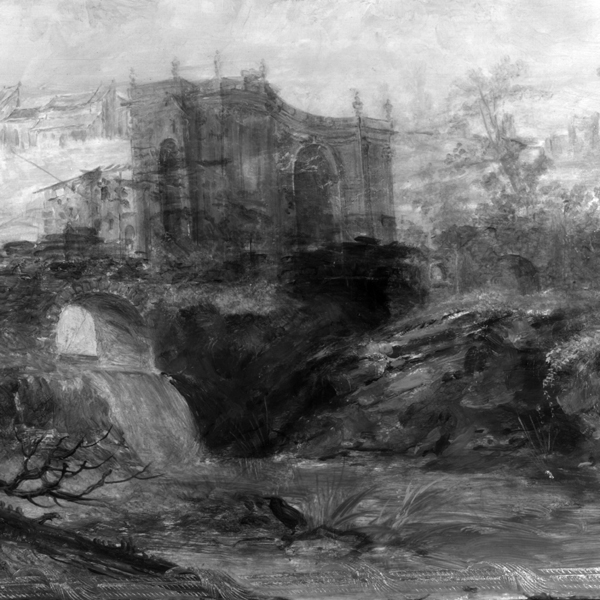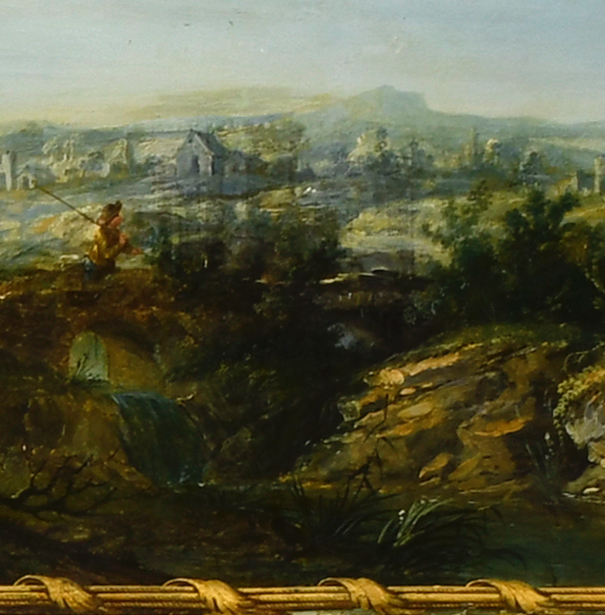A Franco-Flemish double-manual harpsichord,
![]()
Louis XV's Golden Harpsichord
![]()
The painting of
the inside of the lid of
the Franco-Flemish harpsichord
The author of this painting has not yet been determined with certainty. However, experts suggest that it may have been painted by Jean-Baptiste Le Prince (1734-1781), who came to work for Francois Boucher in 1750, the same year that the decoration and ravalement of the harpsichord were carried out. Like the painting of the figures on the top of the lid, it is of extremely high quality and compares with the best Parisian landscape artists active during the period around 1750. It shows a sylvan landscape with groups of figures engaged in rural activities. The figures are painted in a vigorous, free style.
There appears to be an underlying painting below the paint visible near the middle of the photograph above, and this underlying painting seems to occupy only the area above and to the right of the central bridge and tree stump. The area where the underpainting can be seen is compared in the two photographs below: the left photograph is taken with infrared light, whereas the photograph on the right is taken under normal lighting conditions. The 'ghost' image can be seen to be a Triumphal Gate, positioned strangely near the path crossing the bridge, and almost on top of the bridge and waterfall. Unfortunately there now seems to be no way of dating the painting of the Triumphal Gate, and therefore of attributing it. The date of this 'underpainting' in unknown, and it is not known if it is only a pentimento that was painted over by Le Prince.


Photographs of the area of obvious underpainting near the middle of the lid seen in the very top photograph above. The two photographs represent almost exactly the area and position in the lid. The left photo is taken as a time exposure with the area illuminated with infrared light provided by an incandescent lamp, and with a strong infrared filter in front of the lens. This ensures that only the infrared light is detected by the camera, so that only the reflected infrared light is seen in this photograph. What is revealed appears to be a large Triumphal Gate in a kind of strange neo-classical style. The vertical lines of this Gate are, in fact, not vertical, and some additional arches are seen to the right, but not seen at all in the right-hand photograph of the present state.
The whole of the lower part of the painting on the lid and lid flap would have had the unsightly addition of new wood along the spine (lower edge of the photographs above). The fact that there is no obvious addition to the painting along the lower edge of the left-hand photograph above, suggests that the whole of the painting was added at the time of the ravalement by F. E. Blanchet. This therefore would have occurred when he widened the instrument in 1750 and increased the bass compass. This widening would have necessitated either an addition to the original painting (there is no trace of this in the infrared photo on the left), or the replacement of the entire lid section painting with the one seen here with this painting. The lack of any difference in the paintwork on the spine edge of the interior lid painting where the ravalement extension would otherwise have occurred, strongly suggests that the whole of the lid painting (except, of course for the 1786 extension on the treble side) was carried out by le Prince in 1750, and this further suggests that the wood of the main lid section was also replaced by Blanchet in 1750.
![]()
